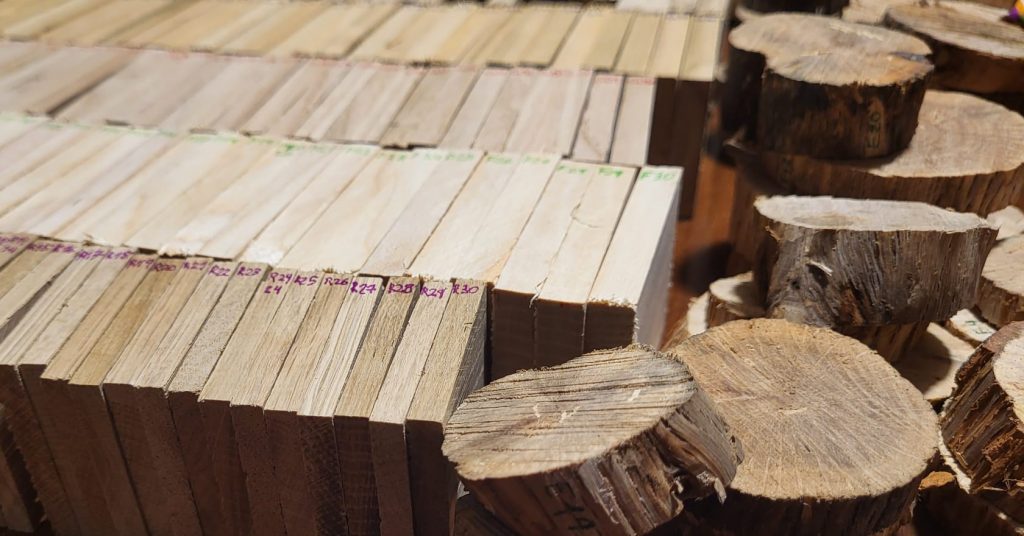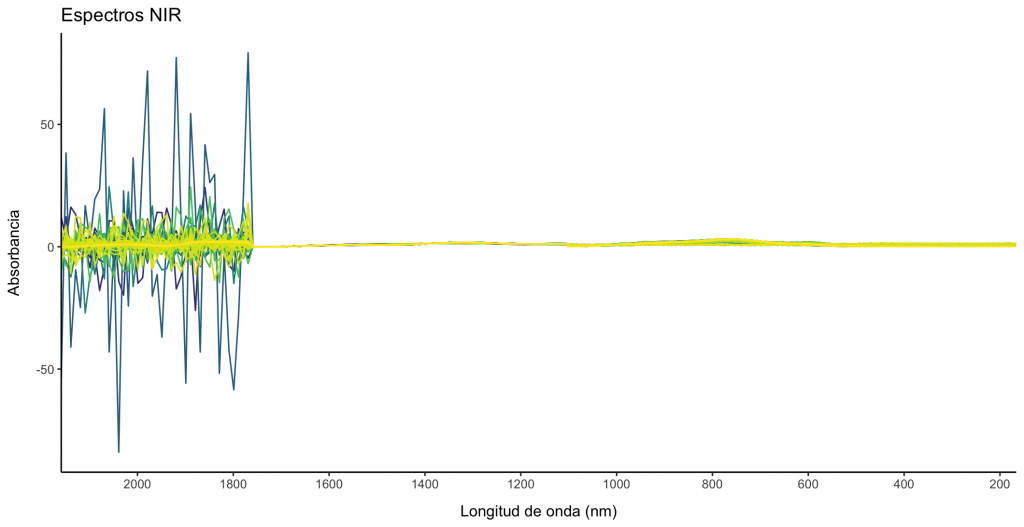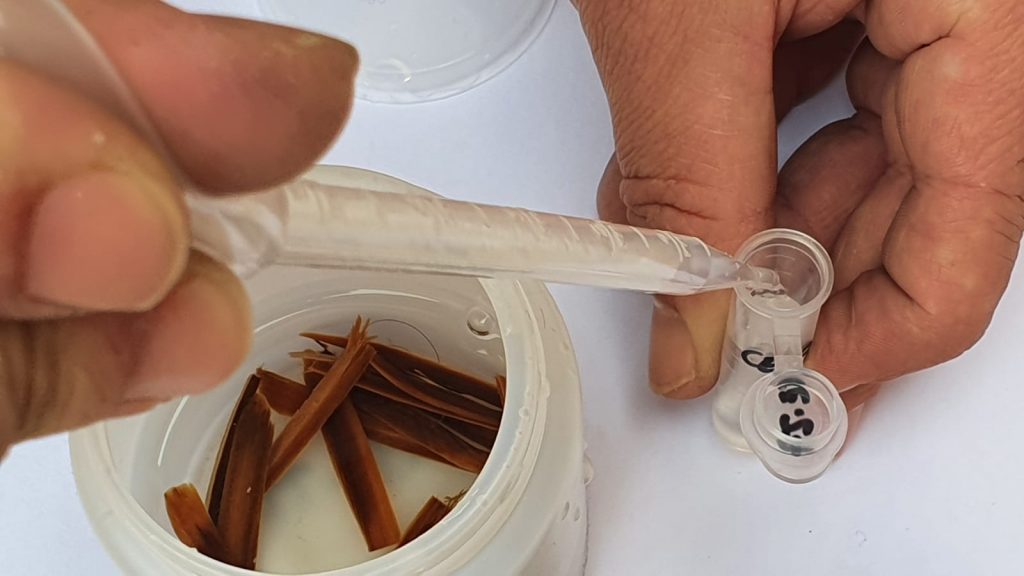TANNIRS

Boscalia Technologies S.L., in collaboration with the Government of Extremadura (Department of Economy, Science, and Digital Agenda) and the European Regional Development Fund (ERDF), has developed the TANNIRS project.
OBJETIVE
The objective of the project is to provide the wine sector with a rapid and effective method based on Vis-NIR spectroscopy to ensure the quality of raw materials of forest origin and to ensure or improve the organoleptic quality of wines. This opens up the possibility of revaluing woods present in the forests of Spain, and specifically in Extremadura, as well as their by-products without commercial use, improving their profitability and the proper management of forest spaces.

DEVELOPMENT
Samples of chestnut, cherry, ash, holm oak, and French oak in cube format were selected, with 30 samples analyzed per species. These samples were provided by forest owners from Extremadura, except for the commercial supplier of the French oak samples.
Analytical Techniques:
The analytical techniques employed were Gas Chromatography-Mass Spectrometry (GC-MS), Vis-NIR, and FTIR-ATR. With GC-MS (SCSIE, UV), data on the content of eugenol, β-methyloctalactone, guaiacol, 4-methyl guaiacol, vanillin, furfural, and 5-methylfurfural were obtained. Vis-NIR spectroscopy techniques (own prototype) and FTIR-ATR (CRETUS-EcoPast, USC) allowed for the registration of the “fingerprint” (physical-chemical) of the wood.
Statistical Analysis:
The peaks of FTIR-ATR were identified using the {andurinha} library of R, and the peaks were selected based on the FTIR-ATR spectroscopy data provided by the online SpectraBase database. In the case of GC-MS data, some of the compounds of interest were detected in all samples, except for three of them.
For predictive models, 9 datasets were used: (i) the total NIR dataset, (ii) NIR from 165 to 1100 nm, (iii) NIR from 1101 to 1700 nm, (iv) NIR from 165 to 1700 nm, (v) the four previous variables with the 79 FTIR-ATR peaks, and (vi) FTIR-ATR without NIR. The algorithms tested were Partial Least Squares Regression, Linear Support Vector Machine, and Random Forest. The data were previously standardized and centered, and the models were trained using the {caret} package in R. The statistical method that yielded the best results was Random Forest. Contrary to expectations, the models obtained with NIR were not very good, with a coefficient of determination (r2) < 0.6. However, a model with good prediction indicators could be obtained with FTIR-ATR data. The r2 values were 0.62 for 5-methylfurfural, 0.73 for eugenol, 0.87 for furfural, and 0.75 for vanillin, with a sensitivity of 0.5 for 5-methylfurfural and eugenol, 0.78 for furfural, and 0.67 for vanillin. The specificity was 0.75 for 5-methylfurfural, 0.96 for eugenol, 0.97 for furfural, and 0.83 for vanillin.

TANNIRS

OBJETIVE
The objective of the project is to provide the wine sector with a rapid and effective method based on Vis-NIR spectroscopy to ensure the quality of raw materials of forest origin and to ensure or improve the organoleptic quality of wines. This opens up the possibility of revaluing woods present in the forests of Spain, and specifically in Extremadura, as well as their by-products without commercial use, improving their profitability and the proper management of forest spaces.


DEVELOPMENT
Samples of chestnut, cherry, ash, holm oak, and French oak in cube format were selected, with 30 samples analyzed per species. These samples were provided by forest owners from Extremadura, except for the commercial supplier of the French oak samples.
Analytical Techniques:
The analytical techniques employed were Gas Chromatography-Mass Spectrometry (GC-MS), Vis-NIR, and FTIR-ATR. With GC-MS (SCSIE, UV), data on the content of eugenol, β-methyloctalactone, guaiacol, 4-methyl guaiacol, vanillin, furfural, and 5-methylfurfural were obtained. Vis-NIR spectroscopy techniques (own prototype) and FTIR-ATR (CRETUS-EcoPast, USC) allowed for the registration of the “fingerprint” (physical-chemical) of the wood.
Statistical Analysis:
The peaks of FTIR-ATR were identified using the {andurinha} library of R, and the peaks were selected based on the FTIR-ATR spectroscopy data provided by the online SpectraBase database. In the case of GC-MS data, some of the compounds of interest were detected in all samples, except for three of them.
For predictive models, 9 datasets were used: (i) the total NIR dataset, (ii) NIR from 165 to 1100 nm, (iii) NIR from 1101 to 1700 nm, (iv) NIR from 165 to 1700 nm, (v) the four previous variables with the 79 FTIR-ATR peaks, and (vi) FTIR-ATR without NIR. The algorithms tested were Partial Least Squares Regression, Linear Support Vector Machine, and Random Forest. The data were previously standardized and centered, and the models were trained using the {caret} package in R. The statistical method that yielded the best results was Random Forest. Contrary to expectations, the models obtained with NIR were not very good, with a coefficient of determination (r2) < 0.6. However, a model with good prediction indicators could be obtained with FTIR-ATR data. The r2 values were 0.62 for 5-methylfurfural, 0.73 for eugenol, 0.87 for furfural, and 0.75 for vanillin, with a sensitivity of 0.5 for 5-methylfurfural and eugenol, 0.78 for furfural, and 0.67 for vanillin. The specificity was 0.75 for 5-methylfurfural, 0.96 for eugenol, 0.97 for furfural, and 0.83 for vanillin.


OBJETIVE
The objective of the project is to provide the wine sector with a rapid and effective method based on Vis-NIR spectroscopy to ensure the quality of raw materials of forest origin and to ensure or improve the organoleptic quality of wines. This opens up the possibility of revaluing woods present in the forests of Spain, and specifically in Extremadura, as well as their by-products without commercial use, improving their profitability and the proper management of forest spaces.
DEVELOPMENT
Samples of chestnut, cherry, ash, holm oak, and French oak in cube format were selected, with 30 samples analyzed per species. These samples were provided by forest owners from Extremadura, except for the commercial supplier of the French oak samples.
Analytical Techniques:
The analytical techniques employed were Gas Chromatography-Mass Spectrometry (GC-MS), Vis-NIR, and FTIR-ATR. With GC-MS (SCSIE, UV), data on the content of eugenol, β-methyloctalactone, guaiacol, 4-methyl guaiacol, vanillin, furfural, and 5-methylfurfural were obtained. Vis-NIR spectroscopy techniques (own prototype) and FTIR-ATR (CRETUS-EcoPast, USC) allowed for the registration of the “fingerprint” (physical-chemical) of the wood.
Statistical Analysis:
The peaks of FTIR-ATR were identified using the {andurinha} library of R, and the peaks were selected based on the FTIR-ATR spectroscopy data provided by the online SpectraBase database. In the case of GC-MS data, some of the compounds of interest were detected in all samples, except for three of them.
For predictive models, 9 datasets were used: (i) the total NIR dataset, (ii) NIR from 165 to 1100 nm, (iii) NIR from 1101 to 1700 nm, (iv) NIR from 165 to 1700 nm, (v) the four previous variables with the 79 FTIR-ATR peaks, and (vi) FTIR-ATR without NIR. The algorithms tested were Partial Least Squares Regression, Linear Support Vector Machine, and Random Forest. The data were previously standardized and centered, and the models were trained using the {caret} package in R. The statistical method that yielded the best results was Random Forest. Contrary to expectations, the models obtained with NIR were not very good, with a coefficient of determination (r2) < 0.6. However, a model with good prediction indicators could be obtained with FTIR-ATR data. The r2 values were 0.62 for 5-methylfurfural, 0.73 for eugenol, 0.87 for furfural, and 0.75 for vanillin, with a sensitivity of 0.5 for 5-methylfurfural and eugenol, 0.78 for furfural, and 0.67 for vanillin. The specificity was 0.75 for 5-methylfurfural, 0.96 for eugenol, 0.97 for furfural, and 0.83 for vanillin.




